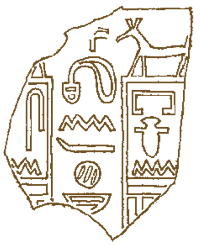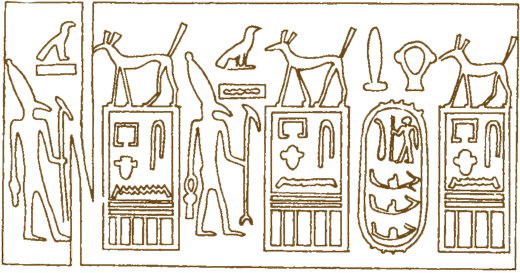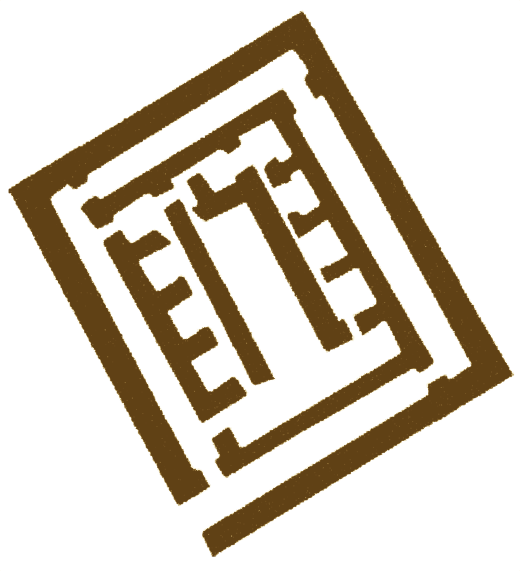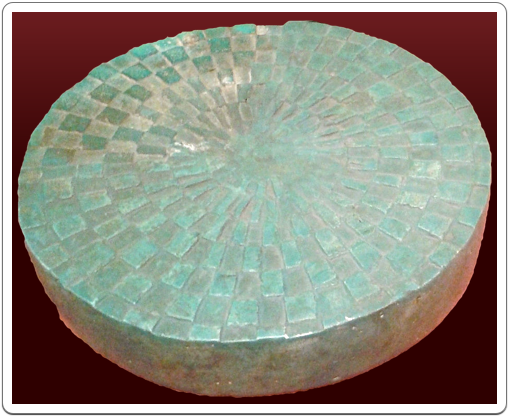Seth Peribsen
Seth
Peribsen is the only king in the history of Ancient Egypt to have had a
Seth Name instead of a Horus Name. This, along with the fact that his
name has only been found in Upper Egypt, suggests that he only ruled
part of the country, while another king, perhaps Horus Sekhemib, took
control of Lower Egypt.

Peribsen Quick Facts
Chronology
Dynasty: 2nd
Predecessors:
Horus Ninetjer (?)
Weneg (?)
Successors:
Horus Sekhemib (?)
Horus-Seth Khasekhemwi (?)Monuments
Tomb: Tomb P at Umm el-Qa’ab
Modern-day Egyptologists have often connected this name change with Ancient Egyptian mythology which saw the god Seth as the murderer of his brother Osiris and the enemy of Horus, son of Osiris. While Seth has often been seen as a god of chaos, the particular mythology that made him the opponent of Horus appears to be of a much more recent date than the 2nd Dynasty and may therefor not have played a role in Peribsen’s choice to have a Seth name.
If the traces on Cairo Fragment CF1 of the Annals Stone following the reign of Ninetjer are indeed the legs of the mythic animal that represents Seth, this may indicate that Ninetjer’s immediate successor bore a Seth Name. Peribsen being the only king known to have done so, would make him Ninetjer’s successor. If that is the case, it is possible that Peribsen, whose name has only been found in Upper Egypt, only ruled part of the country while another king, perhaps the one whose Nebti Name was Weneg, ruled Lower Egypt.
Against the theory that the country was divided, however, it must be noted that some inscriptions found on stone vessels may point to Peribsen as having founded a cult centre for the god Seth in Lower Egypt. Although perhaps merely symbolic or propagandic, clay seals found in his tomb, the oldest known examples of a complete sentence written in hieroglyphs, claim that “The one of Ombos (Seth) has handed over the two realms to his son, the King of Upper and Lower Egypt, Peribsen”. This too could indicate that Peribsen may have ruled both parts of the country for at least part of his reign.
Another consequence of interpreting the traces on CF1 as referring to Peribsen is that later generations of Egyptian chroniclers considered his reign, even though it was only over part the country, as a legitimate one. This is confirmed by the fact that during the 4th Dynasty, several priests were dedicated to Peribsen’s funerary cult. An inscription on the false door of a 4th Dynasty priest named Sheri, may link the name of Peribsen to a name that appears in the later king-lists, Senedj and is often seen as an indication that Senedj and Peribsen were identical.
It has often been proposed that Seth Peribsen was also identical with another historically attested king, Horus Sekhemib, and that he changed his name from one to the other somewhere during is reign. This is based on the find of several sealings bearing the name of Sekhemib during the excavation of Peribsen’s tomb. The fact, however, that these sealing were found at the entrance of the tomb rather than inside, points to Sekhemib having buried Peribsen and thus having been his successor.
 During his reign, Peribsen founded a new royal residence called “Protection of Nubt”, a name referring to one of Seth’s principal cult centres in Upper Egypt, as well as several cities of economical importance. He
also appears to have reformed the country’s administration into a
stricter hierarchical organisation, limiting the power of the officials
who were in charge of the administration.
During his reign, Peribsen founded a new royal residence called “Protection of Nubt”, a name referring to one of Seth’s principal cult centres in Upper Egypt, as well as several cities of economical importance. He
also appears to have reformed the country’s administration into a
stricter hierarchical organisation, limiting the power of the officials
who were in charge of the administration.
Several sealings and inscriptions on jars mention the gods Horus -again an indication that Peribsen’s change in the titulary was not based on a religious aversion against the god Horus-, Nekhbet, Min, Bastet and Ash.

Seal impression showing the name of Seth Peribsen in front of the god Ash.
Source: Petrie, Royal Tombs of the Earliest Dynasties II, pl. XXII.
Peribsen’s tomb was found at the 1st Dynasty cemetery of Umm el-Qa’ab,
rather than at Saqqara, where his immediate predecessors were buried. A
funerary enclosure built of mud bricks was found near the tomb.

Seth Name
This title is a variant of the Horus Name. It was only used by Peribsen.
Africanus: Sethenês (Sened)
Eusebius: (not mentioned?)Alternative names in modern-day literature
Horus-Sekhemib, Sechemib, Horus-Sechemib, Seth-Peribsen
In doing so, he literally distanced himself from his predecessors, although his motivation may also have been pragmatic, as all traces of his reign seem to be limited to Upper Egypt.


View on the remains of Tomb P.
The
tomb is located slightly to the north of the 1st Dynasty tombs. It
measures 21 by 18.5 metres and is entered trough its southwest corner.
Like its 1st Dynasty neighbours, the tomb consisted of a series of rooms
and corridors centring around a large central room. They were made of
brick walls, built in a pit that was dug into the ground. Lacking
subsidiary graves it deviates from the structure of the older royal
tombs at this cemetery, nor does it follow the layout of the underground
gallery-tombs at Saqqara built for Hotepsekhemwi and Ninetjer.

The board of a board game named Mehen was found in the tomb of Peribsen.
A
mudbrick enclosure found near the tomb may have been related to
Peribsen’s funerary cult. Measuring 108 by 55 metres, it was found to
contain a few cult buildings, among them a shrine located in the
southeast corner that consisted of 3 chapels.
Dynasty: 2nd
Predecessors:
Horus Ninetjer (?)
Weneg (?)
Successors:
Horus Sekhemib (?)
Horus-Seth Khasekhemwi (?)Monuments
Tomb: Tomb P at Umm el-Qa’ab
Biography of Seth Peribsen
Using a Seth Name rather than the Horus Name which had become the traditional royal title since Horus Narmer, Seth Peribsen is one of the most enigmatic kings of Ancient Egypt. Peribsen’s motivation for this seemingly drastic change remains open to speculation and may have been personal, religious or political.Modern-day Egyptologists have often connected this name change with Ancient Egyptian mythology which saw the god Seth as the murderer of his brother Osiris and the enemy of Horus, son of Osiris. While Seth has often been seen as a god of chaos, the particular mythology that made him the opponent of Horus appears to be of a much more recent date than the 2nd Dynasty and may therefor not have played a role in Peribsen’s choice to have a Seth name.
If the traces on Cairo Fragment CF1 of the Annals Stone following the reign of Ninetjer are indeed the legs of the mythic animal that represents Seth, this may indicate that Ninetjer’s immediate successor bore a Seth Name. Peribsen being the only king known to have done so, would make him Ninetjer’s successor. If that is the case, it is possible that Peribsen, whose name has only been found in Upper Egypt, only ruled part of the country while another king, perhaps the one whose Nebti Name was Weneg, ruled Lower Egypt.
Against the theory that the country was divided, however, it must be noted that some inscriptions found on stone vessels may point to Peribsen as having founded a cult centre for the god Seth in Lower Egypt. Although perhaps merely symbolic or propagandic, clay seals found in his tomb, the oldest known examples of a complete sentence written in hieroglyphs, claim that “The one of Ombos (Seth) has handed over the two realms to his son, the King of Upper and Lower Egypt, Peribsen”. This too could indicate that Peribsen may have ruled both parts of the country for at least part of his reign.
Another consequence of interpreting the traces on CF1 as referring to Peribsen is that later generations of Egyptian chroniclers considered his reign, even though it was only over part the country, as a legitimate one. This is confirmed by the fact that during the 4th Dynasty, several priests were dedicated to Peribsen’s funerary cult. An inscription on the false door of a 4th Dynasty priest named Sheri, may link the name of Peribsen to a name that appears in the later king-lists, Senedj and is often seen as an indication that Senedj and Peribsen were identical.
It has often been proposed that Seth Peribsen was also identical with another historically attested king, Horus Sekhemib, and that he changed his name from one to the other somewhere during is reign. This is based on the find of several sealings bearing the name of Sekhemib during the excavation of Peribsen’s tomb. The fact, however, that these sealing were found at the entrance of the tomb rather than inside, points to Sekhemib having buried Peribsen and thus having been his successor.

Clay seal with the names of Peribsen and one of his seal-bearers.
Several sealings and inscriptions on jars mention the gods Horus -again an indication that Peribsen’s change in the titulary was not based on a religious aversion against the god Horus-, Nekhbet, Min, Bastet and Ash.

Seal impression showing the name of Seth Peribsen in front of the god Ash.
Source: Petrie, Royal Tombs of the Earliest Dynasties II, pl. XXII.
Titulary of Seth Peribsen

Seth Name
This title is a variant of the Horus Name. It was only used by Peribsen.
- stX pr ib=snSeth who has come forth (from) their heart
- nb.tj pr ib=snThe Two Ladies, the one who has come forth (from) their heart
- pr ib=snThe one who has come forth (from) their heart
- snd
- snd
- sndi
- snD
- swndSened (in variant spellings)
Africanus: Sethenês (Sened)
Eusebius: (not mentioned?)Alternative names in modern-day literature
Horus-Sekhemib, Sechemib, Horus-Sechemib, Seth-Peribsen
Tomb P at Umm el-Qa'ab
After at least three of his predecessors being buried in Saqqara, Seth Peribsen chose to return to the 1st Dynasty royal cemetery for his own burial in a tomb labeled “Tomb P” by its excavators.In doing so, he literally distanced himself from his predecessors, although his motivation may also have been pragmatic, as all traces of his reign seem to be limited to Upper Egypt.

Map of tomb P, built for Seth Peribsen, at Umm el-Qa’ab.

View on the remains of Tomb P.

The board of a board game named Mehen was found in the tomb of Peribsen.
ليست هناك تعليقات:
إرسال تعليق